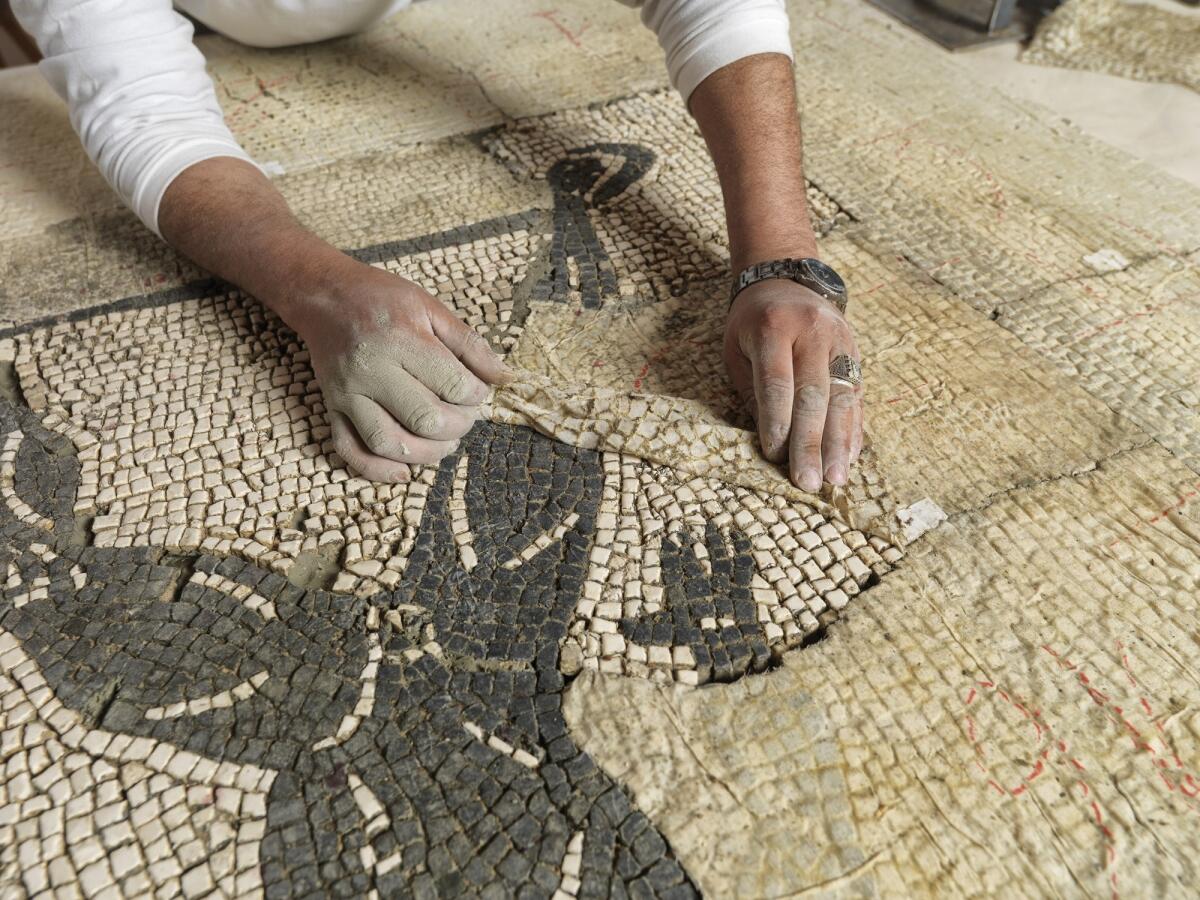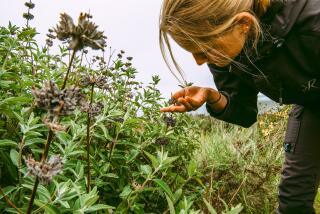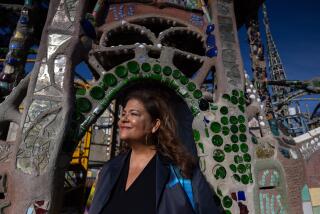Getty mosaic program teaches conservation in conflict zones and beyond

The scene shows a fair woman with red curls being abducted on a chariot by a determined, bearded figure. It’s not a movie or TV show but an ancient mosaic that tells the story of the Greek goddess Persephone, kidnapped by Pluto and dragged against her will to the underworld. Uncovered this month in Amphipolis, Greece, this exquisite work of art resides in a tomb that dates back to the 4th century BC -- a tomb that may contain the remains of an important figure connected to none other than Alexander the Great.
The Mediterranean is home to an unparalleled trove of ancient mosaics such as these, as evidenced by the incredible finds at Amphipolis. The Greeks popularized the art form in the 4th century BC, and the Romans exported it all over their empire, to the northern edges of Africa (present-day Libya, Tunisia and Egypt) and the Middle East (Jordan and Syria). Construction of a highway in Lod, Israel, in 1996 turned up one of the most famous examples of an ancient mosaic: a fantastical Roman design featuring a bevy of animals.
But despite the omnipresence of ancient mosaic art, the business of maintaining, extracting and protecting it is a fraught enterprise. Unlike marble sculpture, which can weather the elements with some grace, mosaics are far more fragile. If the cement that binds them together crumbles, all archaeologists are left with is a pile of brightly colored tiles, and little idea of how they might have come together to form an image.
Looting, poor conservation practices and a couple of millenniums of regional conflicts (including the current Syrian civil war) have taken a toll on many ancient mosaics. Moreover, the few trained conservators who might have expertise in conserving these pieces often reside in the West and simply can’t be present at all the places they’re needed.
But an international effort, led in part by the Getty Foundation, is aiming to change all that by training conservators in countries around the Mediterranean to manage and care for their own cultural heritage.
Mosaikon, as the program is called, is a collaboration between the foundation, the Getty Conservation Institute (GCI), the International Center for the Study of the Preservation and Restoration of Cultural Property (ICCROM) and the International Committee for the Conservation of Mosaics (ICCM) -- the latter two of which are based in Europe.
“There had been some efforts to teach people in the region to care for mosaics -- but they had been uncoordinated,” said Joan Weinstein, deputy director at the Getty Foundation. “One of the challenges of earlier years was that [individual countries] were always importing experts who could provide a short-term fix for a problem. But this didn’t lead to sustainable solutions.”
Since 2008, when the program was launched, Mosaikon has gathered teams of conservators from countries such as Syria, Libya and Jordan and trained them in the latest mosaic-conservation techniques. Leading many of the sessions has been Roberto Nardi, a founder of the Centro Di Conservazione Archeologica (CCA), a conservation organization in Rome.
“We not only teach them the techniques for the restoration of mosaics,” said Nardi, who is also a vice president at ICCM. “We give them tools to understand the problems. We teach them about the ways to use digital photography, the computers. We teach them English, because if they want to be connected to other professionals, they need English. It is a very complete program.”
The sessions are held at the CCA, in an old 13th century monastery outside of Rome, where participants learn the techniques of the craft by working on ancient mosaics.
“We receive mosaics from the archaeological museums,” Nardi said. “The museum is very happy because they get mosaics restored for free. At the same time, the participants work on the real thing.”
In addition, Mosaikon has worked on developing further professional resources for mosaic-conservation workers in the Middle East. This has included translating key texts into Arabic, developing professional websites so that trainees have the ability to access information and connect with their peers, and helping antiquities departments plan or refurbish their conservation laboratories.
“We’ve also worked with the directors-general of antiquities of all the countries in the region,” said the Getty’s Weinstein. “This past January, we brought them all together for a meeting. And we will bring them together again next year. It’s really about getting a commitment from the authorities to support the work of the people who have been trained.”
Thus far, the Getty Foundation has committed $6 million to the effort.
And it seems to be paying off. Moutaz Alshaieb, a young graduate student in Syria who participated in a Mosaikon conservation workshop in June of 2013, has worked on five mosaics in his home country. He said the program provided him with a world of information about new techniques and materials.
“I learned how important [it is] to save and let the mosaic panel [stay] in its original location, and how to renovate it,” he said via email from Damascus. “Now I’m working in the project of the Umayyad mosaic panel that [was] exposed to fire from 1893 AD.”
He is not the first Mosaikon-trained conservator to work on the famous Umayyad Mosque, which dates to the early 8th century, and is covered in extravagant mosaics depicting idyllic landscapes. In June of this year, Burhan al-Zaraa and Muhammad al-Kayed, who trained with Nardi in 2011 and 2012, worked on restoring mosaics at the mosque that had been damaged by mortar shells.
Though the Mosaikon program was launched well before the Arab Spring protests of 2010, and all of the subsequent unrest in the region, it comes at a crucial time for cultural heritage in places such as Syria and Libya -- where political conflict not only threatens the lives of its citizens, but thousands of years’ worth of regional cultural history.
Mustafa Turjman is the head of archaeological research for the Department of Antiquities in Libya, a country that has mosaic masterpieces at sites such as Cyrene, an ancient Greek and Roman settlement that is now listed as a UNESCO World Heritage Site.
“It is very wise to exploit the current time in Libya to qualify people who work in [the] field of archeology,” Turjman wrote via email from Tripoli. “So when things come back to normal we find our people qualified and ready to practice what they have learned. Surely such kind of trainings will yield fruitful results.”
Alshaieb also says it is important for him to think about ways in which he can help preserve his country’s heritage: “I’m learning a lot of new things in mosaic conservation that will help me so much in using these techniques to save our splendor heritage. Syria needs now more conservators to stand together.”
Conservation leader Nardi said the Middle East, in particular, has some spectacular Roman mosaics.
“The center of the empire was Rome,” he said. “But the Middle East was the source of the business. The grain producers were in Egypt. The spice and perfume producers were in Syria and Turkey. There are mosaics all over the the Mediterranean, but the ones that you find in the Middle East and Turkey are the richest and of the highest quality, higher than in Italy or England.”
These are important to preserve, he said, because they reveal a lot about the cultures who made them. And, in many cases, they are often the last remaining piece of an ancient historical puzzle.
“Mosaics were the floors of rich houses,” Nardi said. “But because most villas are not standing up anymore, what is left? Many times the floor mosaics. And through the mosaics it is possible for archaeologists to understand aspects the life of the owners of the villa.”
The next step for Mosaikon is to train the teachers who will pass down all of this conservation knowledge in each of their home countries. And, over the course of the next few years, some individuals will be invited back for further training.
“They will teach everything from teaching skills to budgeting to managing projects,” Weinstein said. “The idea is that you see a network start to take shape.”
Information will be passed down. Resources will be pooled. Conservators will be able to collaborate and share their expertise with one another. Nardi said that a single trained conservator can make a huge difference.
“We don’t need big numbers,” he said. “Ten people can make the difference.”
Find me on Twitter @cmonstah
More to Read
The biggest entertainment stories
Get our big stories about Hollywood, film, television, music, arts, culture and more right in your inbox as soon as they publish.
You may occasionally receive promotional content from the Los Angeles Times.











